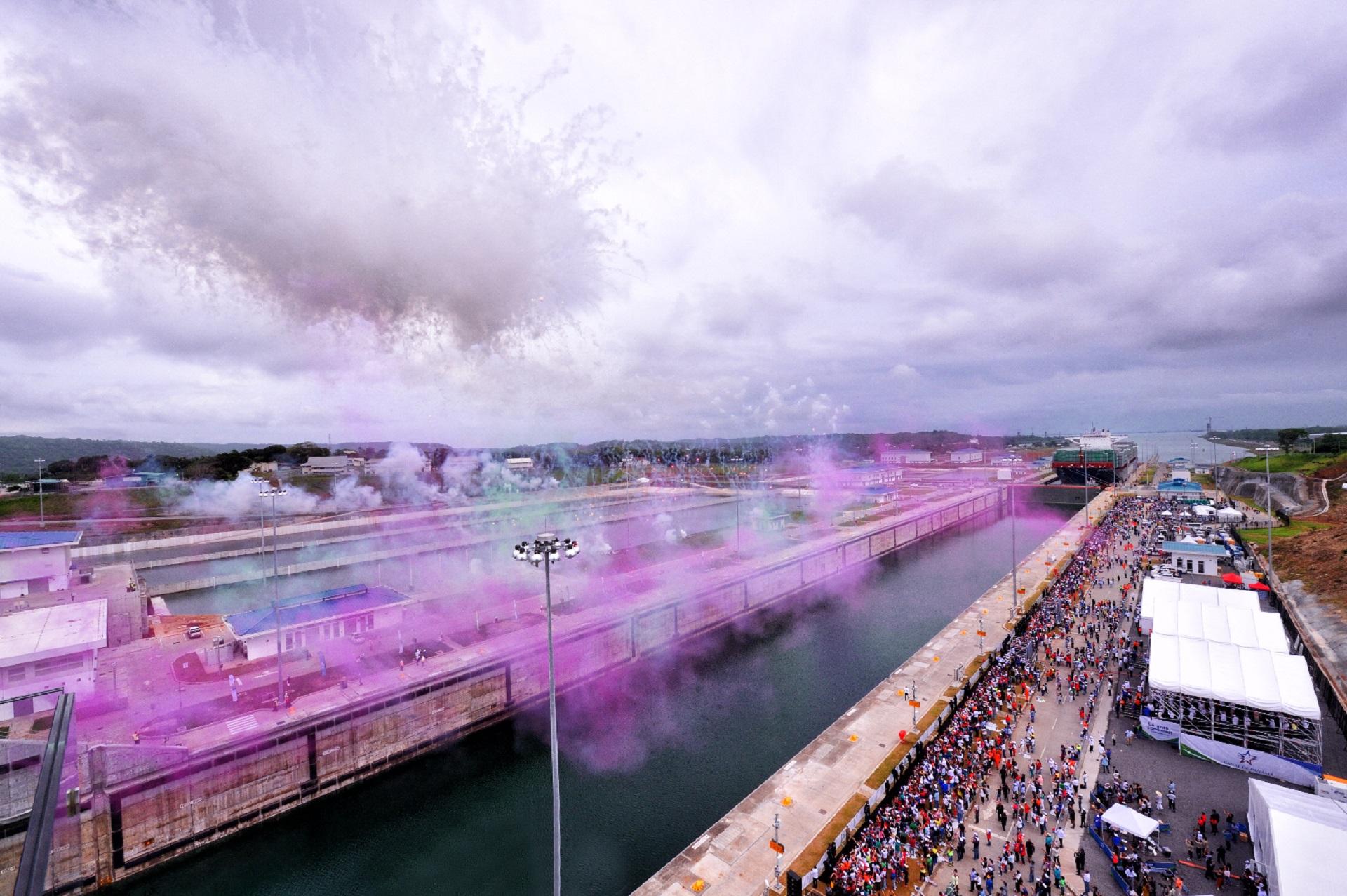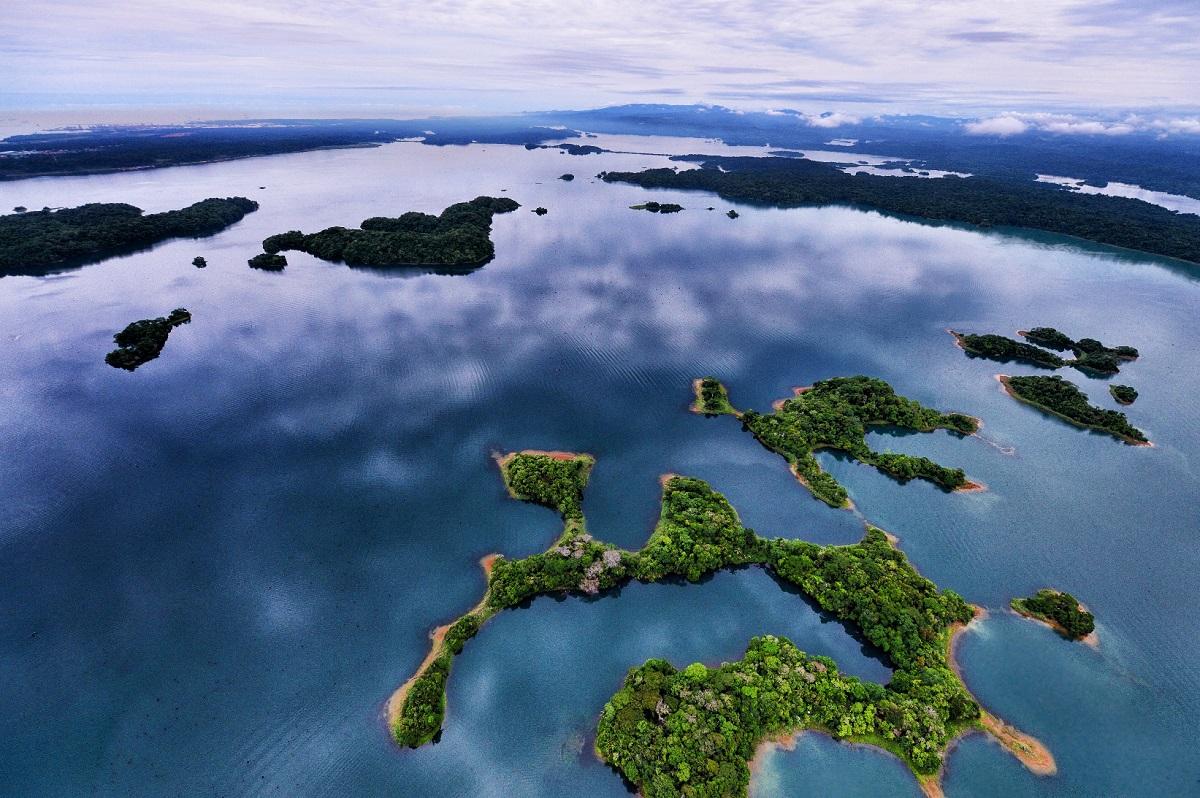Expansion of the Panama Canal - Third set of locks

The project, defined as the most important engineering work of the 21st century, involved the creation of a new set of locks that, complementing the existing one, allows the transit of larger ships, increasing commercial traffic in response to the development and continued expansion of the shipping transport market.
The construction of the third set of locks for the canal allows the passage of larger ships known as Post Panamax, with a capacity of up to 12,600 TEUs with a length of 366metres and maximum width of 49 metres. The previous system of locks allowed the passage of Panamax type ships, with one third of the capacity with a maximum length of 294 metres, a maximum width of 32 metres and a draught of 12 metres.
Specifically, the project involved the construction of two sets of triple step locks: one triple step lock on the Atlantic side and one on the Pacific side. These locks allow ships to be raised from the level of the oceans to Gatun Lake (midway between the two oceans), and vice versa, in less than two hours. Each of the three chambers that make up each lock is 55 metres wide, 427 metres long and 23 to 33 metres deep, and is equipped with horizontally sliding gates systems which can overcome the difference in level of approximately 27 metres between the oceans and Gatun Lake.
The New Panama Canal is a revolution for global trade. The approximately 12 thousand ships that currently cross it each year, will be connected to 1,700 ports belonging to 150 countries and to 144 maritime routes.
Lock Gates
The efficient and safe operation of the locks is regulated and guaranteed by horizontally sliding gates which (similar to the “mitre”-type gates of the existing locks) involve tried and tested technology and are used in installations of this type.
These lock gates, operated by electric winches, take approximately 3-4 minutes to open/close the locks.
The dimensions of these lock gates are impressive, 23-33 metres tall, approximately 10 metres wide and approximately 58 metres long.
Environmental impact: water saving basins and water re-utilisation
Research conducted has led to an environmentally and socially sustainable development strategy aimed at reducing the impact on the area, the environment and the population.
Special attention has been paid from the design stage onwards to reducing water consumption from the Gatun Lake during the transit stages.
A new system was designed for this purpose, known as water saving basins, which allows the recovery and partial re-utilisation of the water from the Gatun Lake through the introduction of auxiliary basins. This has resulted in a 60% water saving and transit which would require the use of approximately 500 million litres of water can now take place with approximately 200 million litres.
MAIN TECHNICAL DATA:
Dredging: 7,100,000 m³
Excavations: 74,000,000 m³
Backfilling: 18,000,000 m³
Concrete: 5,000,000 m³
Cement: 1,600,000 tons
Steel reinforcements: 290,000 tons
Steel used for the sluice gates and for the valves: 71,000 tons
Buildings (96 units): 40,000 m²
This is how Pietro Salini greeted, in 2016, the inauguration of the new Panama Canal: the work built by the international consortium Grupo Unidos por el Canal headed by Salini Impregilo, now Webuild.

"Seven years ago we began a long journey that represented the dream as well as the challenge that every entrepreneur and every person would want to have at least once in their lifetime: building a project that will change global trade"
To cross the New Panama Canal is a voyage in time: a voyage across the green waters of Lake Gatùn that, by leaping from one ocean to another, bisects America
The new Panama Canal is far more than a physical structure. It is an everlasting gift to world trade. It plants the seeds of a new industrial revolution, one in which water, not steel, will dominate, accompanied by ships, ports and cargo.
One century on from the foundation of the Panama Republic and, even more significantly, from the inauguration of the Canal, international trade prepares another phase of international growth, thanks to the expansion of the Canal that bisects the continent and unites the Atlantic with the Pacific. The expansion programme actually involves the construction of a new Canal alongside the original, opened in 1914, usable by ships 366 m long, with a capacity of up to 12,600 containers – three times the current limit.
It includes several parts, the most significant of which is the Third Set of Locks project, which was assigned to a international consortium called the Grupo Unidos por el Canal (GUPC), made up of leading infrastructure and engineering companies: Italy’s Salini Impregilo - now Webuild - Spain’s Sacyr and Belgium’s Jan de Nul, together with CUSA from Panama.
With 74 million cubic metres of excavations, 5 million cubic metres of concrete, 1.6 million tons of cement and 7.1 million cubic meters of dredging, the Third Set of Locks Project is the biggest feat of human construction to take place in several decades.
Modern ships – known as ‘Post-Panamax’ to mark the start of a new era in shipping, exceeding the limits of the previous canal – cross the Panamanian isthmus using a system of locks delimited by enormous rolling gates designed and built in Italy. The movement of locks lifts ships a height of 27 m above sea level to Gatun Lake, the world’s largest artificial basin, giving them an easy journey by bypassing the rainforest and the oceans – like a kind of flyover for ships. Having reached the other side, the locks at the entry to the other ocean will return the ships to sea level. The procedure for getting these new giants of the sea into, out of, up and down the locks requires pinpoint accuracy. Each gate takes less than five minutes to open or close and is expected to remain in service for at least another hundred years.
There is little margin for error: there are only a few centimetres between the gates and their reinforced cement mounts. On average they are 23-33 m tall, 10 m wide, and 58 m long. And each weighs 4,000 tons. It is a real “masterpiece” of engeneering creativity and technical excellence.

Sustainability: Water Saving
The consortium solved the problem of the environmental impact and high water consumption thanks to a system called Water Saving Basins: it reduces the dispersion of water in the ocean, with 60% water saving. For the rainforest and its inhabitants, protective measures were taken during the project: hundreds of species typical of the tropical habitat were rescued in the process.
Panama Canal: the story in pictures
Salini_Impregilo_39902_0
